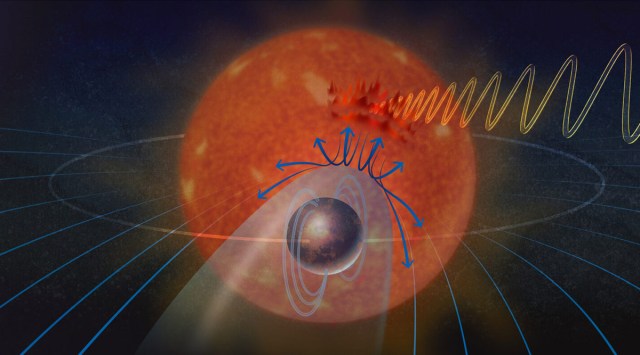Repeating radio signal hints alien planet could host extraterrestrial life
A repeating radio signal from a dwarf star about 12 light years away from our planet suggests that one of its stars could potentially host life.
 The Radio signals from the YZ Ceti system suggests that one of its planets has a magnetic field. (Image credit: University of Colorado Boulder)
The Radio signals from the YZ Ceti system suggests that one of its planets has a magnetic field. (Image credit: University of Colorado Boulder) Researchers have detected radio signals from a planet about 12 light-years from Earth, suggesting that the planet could be habitable to life.
According to the University of Colorado Boulder, the radio signal from the rocky planet YZ Ceti b suggests that it could have its own magnetic field, something that is essential to life on Earth.
Our planet’s magnetic field is quite important, and it does more than just make compass needles point north. It deflects high energy particles and plasma from the Sun, protecting our atmosphere and thereby, all life on Earth.
In a research article published in the journal Nature, astronomers document how they observed a repeating radio signal from the star YZ Ceti using the Karl G Jansky Very Large Array, a radio telescope in the United States.
“Whether a planet survives with an atmosphere or not can depend on whether the planet has a strong magnetic field or not,” said Sebastian Pineda, lead author of the paper. Pineda is a research scientist at the Laboratory for Atmospheric and Space Physics (LASP) at the University of Colorado, Boulder.
According to Joe Pesce, program director of the US National Science Foundation (NSF), the search for potentially habitable or life-hosting worlds in other solar systems depends on the ability to determine if rocky, Earth-like exoplanets have magnetic fields. The new research has not only shown that YZ Ceti b might have a magnetic field, but it also provides a new method to find more such planets.
The Independent reports that the detected radio waves seem to be generated when the star interacts with its planets’ magnetic fields. The two celestial bodies are so quite close together and because of this, the planet and star are an ideal pair to test theories about whether those magnetic fields could be detectable at distance.
“We’re actually seeing the aurora on the star — that’s what this radio emission is. There should also be aurora on the planet if it has its own atmosphere,” said Pineda to The Independent.
The search for extraterrestrial life seems to be heating up in recent years. Earlier this month, a Harvard scientist and a US Department of Defense official authored a research article exploring the possibility of an alien mothership in our solar system sending “mini-probes” to explore Earth and other planets.







